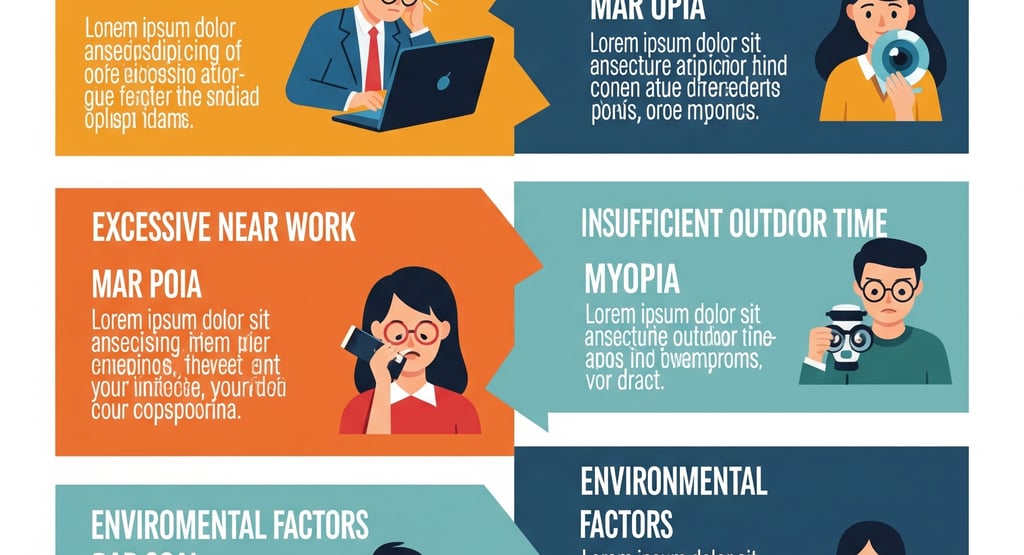Causes of Myopia, Genetics and the Role of Genes in Myopia
2/2/20257 min read


What is Myopia?
Myopia, commonly referred to as nearsightedness, is a prevalent refractive error that affects the way light is focused in the eye. Individuals with myopia can see nearby objects clearly, while distant objects appear blurry. This condition arises due to the shape of the eye being elongated or the cornea having too much curvature, which prevents light from focusing directly on the retina. Instead, light focuses in front of the retina, resulting in impaired distance vision.
The symptoms of myopia typically include difficulty seeing at a distance, which can affect everyday activities such as driving, watching television, or participating in sports. Additionally, individuals may experience eye strain, headaches, or fatigue during prolonged periods of concentration, particularly when engaging in tasks that require distance vision. Early detection and correction through eyeglasses or contact lenses can significantly enhance the quality of life for those affected.
Myopia is increasingly common, particularly among school-aged children and adolescents. Studies indicate a growing prevalence of myopia in various regions of the world, attributed to lifestyle factors, including increased indoor activities and decreased time spent outdoors. As children increasingly engage with screens and digital devices, the rates of myopia continue to rise, leading to concerns about its long-term implications for educational performance and overall well-being.
In educational settings, students with myopia may struggle to view whiteboards or see presentation materials clearly, impacting their ability to learn effectively. Moreover, if left uncorrected, myopia can progress, potentially leading to more severe visual impairments, such as glaucoma or retinal detachment later in life. Understanding myopia and its implications is crucial for both parents and educators in supporting children's vision health and academic success.
The Anatomy of the Eye and Myopia
The human eye is a complex organ responsible for capturing light and converting it into visual signals processed by the brain. Understanding myopia, commonly known as nearsightedness, requires a closer examination of the eye's anatomy, particularly focusing on the lens, retina, and overall shape of the eyeball. Myopia arises when light entering the eye does not focus directly on the retina, resulting in blurred vision for distant objects.
At the forefront of this process is the lens, a transparent structure that changes shape to focus light onto the retina. In a normally functioning eye, the lens adjusts its curvature to accommodate various distances, ensuring clear vision. However, in individuals with myopia, the shape of the eyeball is often elongated. This elongation causes light rays to converge prematurely, leading to a focal point that falls short of the retina. Consequently, distant objects appear blurry, while close objects can still be seen clearly.
Another essential component in this narrative is the retina, the light-sensitive layer lining the back of the eye. The retina contains photoreceptor cells that convert light into nerve signals, which are then relayed to the brain. In myopia, the altered eye shape may not only hinder distance vision but also affect the distribution of these photoreceptors, impacting overall visual clarity. Research has indicated that specific genetic factors can influence both the size and shape of the eyeball, thereby increasing the risk of myopia.
Furthermore, environmental factors such as prolonged near work and limited outdoor activities are considered contributing elements in the rising prevalence of myopia. This multifaceted condition highlights the intricate relationship between the eye's anatomy and its functional efficacy, underscoring the importance of understanding myopia from both genetic and environmental perspectives.
Genetic Factors in Myopia Development
Myopia, or nearsightedness, is increasingly recognized as a multifactorial condition with significant genetic underpinnings. Numerous studies have indicated a strong hereditary component associated with the development of myopia, suggesting that individuals with a family history of nearsightedness are at a greater risk of developing the condition themselves. Heritability estimates for myopia vary, but research indicates that genetic factors contribute considerably to its prevalence in populations worldwide.
Research has identified various genetic markers that correspond to an elevated risk of developing myopia. For instance, genome-wide association studies (GWAS) have pinpointed specific loci—regions of the genome—that show a significant association with refractive error. These markers, which include variations in genes related to eye growth and development, suggest pathways through which hereditary influences may affect ocular shape and length, contributing to myopia. Furthermore, genes involved in the regulation of visual system development have also been implicated as potential contributors to the onset and progression of nearsightedness.
Beyond isolated genetic factors, the interaction of multiple genes likely plays a significant role in myopia's complexity. The polygenic nature of myopia implies that it cannot be attributed to single genetic alterations but rather to a combination of several genes, each of which may possess a small effect size. Environmental factors, such as prolonged near work and limited outdoor activities, interact with these genetic predispositions, thereby exacerbating the risk of myopia in susceptible individuals.
In summary, the genetic factors influencing the development of myopia are becoming clearer through ongoing research, revealing a complex interplay between multiple genes and environmental stimuli. Understanding these genetic associations not only aids in informing potential therapeutic approaches but also guides screening and preventive measures for at-risk populations.
Key Genes Associated with Myopia
Recent genetic research has illuminated several key genes that play a significant role in the development of myopia, commonly known as nearsightedness. Understanding these specific genes assists scientists in uncovering the underlying mechanisms that contribute to refractive errors and eye development. A pivotal study by Hsu et al. identified the gene MYOC, which is associated with ocular growth. Variations in this gene can influence the elongation of the eyeball, a primary factor in myopia progression.
Another notable gene is GJD2. This gene has been implicated in the regulation of retinal signaling processes. Changes in the GJD2 gene can affect the communication within retinal cells, which is vital for maintaining proper eye shape and function. Furthermore, the research conducted by Wang et al. highlights RAX, a gene crucial in early eye development, demonstrating that mutations in this gene can lead to distortions in eye structure, ultimately resulting in myopia.
The gene AXL has also been linked to refractive errors. A study revealed that it plays a role in the signaling pathways that affect the growth of eye tissues. Genomic analyses have detected various single nucleotide polymorphisms (SNPs) within these genes that correlate strongly with myopia susceptibility. These discoveries indicate that myopia is a polygenic disorder, where multiple genes interact with environmental factors to increase the likelihood of developing nearsightedness.
More comprehensive genetic studies are contributing to the foundation of our understanding about myopia. Continuing to explore these gene-environment interactions will aid in forming prevention and treatment strategies, potentially reducing the burden associated with this prevalent visual impairment.
Environmental Influences on Myopia Progression
While genetics play a significant role in the development of myopia, environmental factors also contribute to its severity and progression. One crucial aspect is lifestyle choices, particularly the amount of time spent engaged in near-vision tasks. As individuals increasingly rely on screens for work and leisure, there is a growing concern about the impact of prolonged screen time on eye health. Studies have suggested that extensive use of computers, tablets, and smartphones is associated with a higher incidence of myopia, hinting at the need for balance in visual activities.
Outdoor activities also play a pivotal role in mitigating the risk of developing severe myopia. Research indicates that children who spend more time outdoors tend to have a lower risk of nearsightedness. Exposure to natural sunlight is believed to be beneficial due to its role in dopamine production, which may inhibit excessive elongation of the eyeball—a primary factor in myopia progression. Encouraging children and adolescents to engage in outdoor play can be an effective strategy in combating the rise of myopia.
Moreover, educational demands and the pressure associated with academic performance have been linked to an increase in myopia. With more students engaging in intensive study routines and homework—often involving close-up tasks—an environmental interaction is observed alongside genetic predispositions. The combination of these academic pressures and screen-related activities can potentially exacerbate the risk of developing more severe forms of myopia.
In summary, while genetic factors are undeniably significant in understanding myopia, environmental influences such as lifestyle choices, screen time, and educational pressures also interact with genetic predispositions. Recognizing and addressing these factors is vital in formulating effective strategies to manage and potentially reduce the progression of myopia in individuals, particularly in younger populations.
Myopia: Current Research and Future Directions
The genetic basis of myopia, commonly referred to as nearsightedness, has garnered significant attention in contemporary research. Researchers have been making strides in identifying specific genes associated with myopia, enhancing our understanding of its hereditary components. The recent identification of multiple genetic loci has opened new avenues for exploring the biological pathways that lead to this refractive error. This ongoing gene discovery effort uses high-throughput sequencing techniques and genome-wide association studies, both of which have proven instrumental in pinpointing variants linked to myopia susceptibility.
One of the critical areas of focus in current research is understanding how environmental factors, such as increased screen time and reduced outdoor activity, interact with genetic predispositions to influence the progression of myopia. These insights may lead to innovative approaches aimed at preventing or mitigating the condition. For instance, integrating genetic data with lifestyle considerations could enable healthcare professionals to design personalized interventions for at-risk populations.
Furthermore, advancements in genetics are paving the way for potential therapeutic strategies. An emerging concept involves gene therapy or interventions that modify the expression of genes implicated in myopia. Although this is still in the experimental stages, preliminary findings are promising and may eventually yield viable treatment options. Additionally, researchers are examining pharmacological approaches that target the biological mechanisms underlying myopia progression, potentially providing effective treatment alternatives in the future.
In summary, the ongoing research into the genetic factors associated with myopia is gradually shaping our understanding of this prevalent refractive error. With continuous advancements in genetics and the integration of environmental variables, there is an optimistic outlook for developing targeted treatments and preventative measures that could ultimately reduce the prevalence and impact of myopia globally.
Conclusion
Understanding the genetic factors behind myopia, or nearsightedness, sheds light on a condition that affects a significant portion of the global population. The intricate interplay between genetic predisposition and environmental influences plays a crucial role in the development and progression of myopia. It is essential to acknowledge that while genetics account for a considerable aspect of myopia, environmental factors such as prolonged screen time, lack of outdoor activities, and educational pressures also significantly contribute to its onset.
Research indicates that individuals with a family history of myopia are more likely to experience similar vision challenges. This emphasizes the role of heredity in nearsightedness. By understanding these genetic links, healthcare professionals can better predict who may be at higher risk for developing myopia and implement early interventions. Moreover, this heightened awareness encourages families to engage in preventive measures, such as ensuring children spend ample time outdoors and limiting screen exposure, to combat the potential exacerbation of myopia symptoms.
As we delve deeper into the genetic aspects and their implications, it becomes increasingly important to foster a culture of research and education surrounding myopia. Parents, educators, and health professionals should collaborate to promote awareness and understanding of how genetic susceptibility might influence vision health. Investing time in studies focused on genetic factors can lead to new insights and treatment options, ultimately improving life quality for those affected by myopia.
In summary, acknowledging the significance of both genetic and environmental factors in myopia is paramount. Through continued research and increased awareness, we can empower individuals and communities to take proactive steps in managing this pervasive condition. Ultimately, understanding myopia from a genetic perspective will enhance our comprehensive approach to prevention and treatment, paving the way for healthier visual futures.
